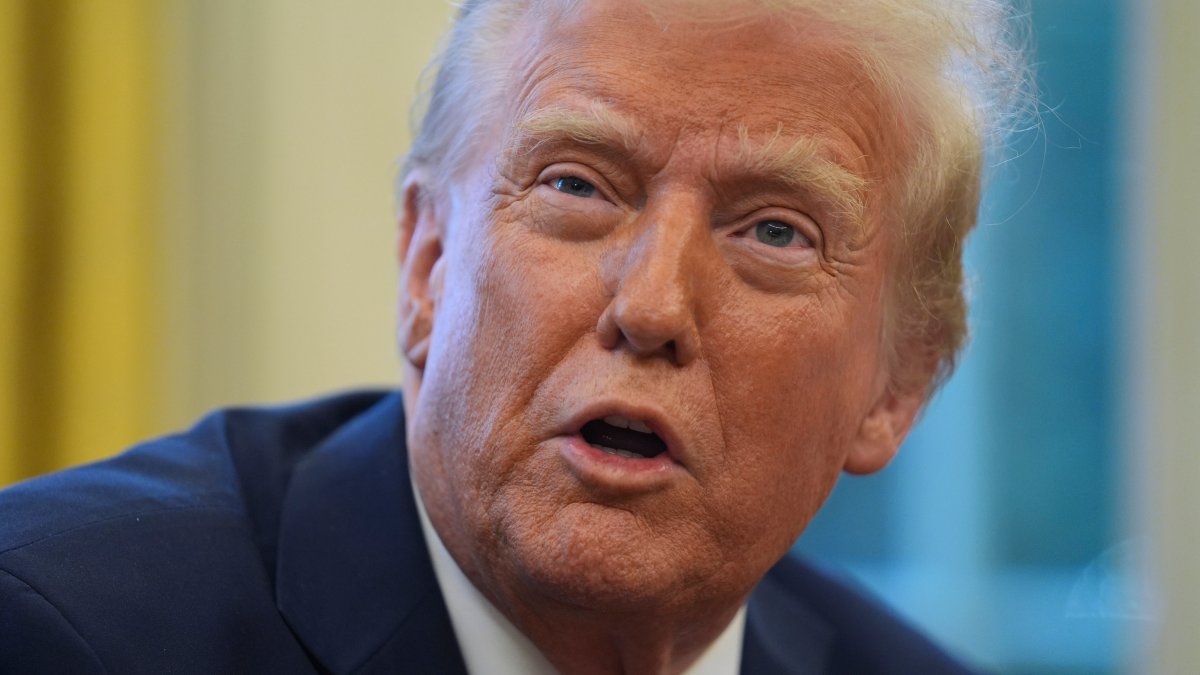IF YOU WANT TO UNDERSTAND how mindlessly destructive Donald Trump’s latest move on climate could be, just look at the response from the groups that you would expect to be cheering it most loudly.
The move came on Tuesday, when the Environmental Protection Agency announced it was preparing to smash the legal foundation for government limits on greenhouse gases. The plan is for EPA to revoke its “endangerment finding” that formally recognizes global warming as a threat to public health.
That finding—issued in 2009 under the Obama administration—gave EPA authority to regulate emissions from cars, power plants, factories, and other sources of pollution. Withdrawing the finding would give the Trump administration license to eliminate those regulations.
And while the process of revoking the endangerment finding will take at least a few months—like any other new rule, it first has to go through a period of public comment—the administration isn’t wasting any time. On the very same day it announced its intentions on the endangerment rule, the EPA also said it intends to get rid of the motor-vehicle emissions limits.
Speaking at an Indianapolis truck dealership, EPA administrator Lee Zeldin described the agency’s plans for the endangerment finding as “the largest deregulatory action in the history of the United States.” That might not be an exaggeration. The New York Times, which broke the news of the announcement several days before, called it a “game-changing climate rollback.”
On first blush, it was also the ultimate wish fulfillment for an industry coalition that in 2009 had screamed about the finding and subsequently—and unsuccessfully—tried to stop it in court. Back then, trade organizations like the Edison Electric Institute (which represents power companies) and the National Association of Manufacturers were making many of the same arguments Trump officials made last week: that the EPA had overstepped its authority and relied on bad science, and that the resulting regulations would unleash all kinds of economic damage.
The finding could lead to “a top-down command-and-control regime that will choke off growth by adding new mandates to virtually every major construction and renovation project,” the then-head of the U.S. Chamber of Commerce warned at the time.
But if you checked out the websites and social media feeds of those organizations last week, all you saw was the digital equivalent of crickets. Groups weren’t putting out public statements or dispatching officials to hail the move. They also weren’t answering reporter queries, at least based on those I sent to the Edison Institute and the Manufacturers, as well as the auto-industry lobby.
In fact, the only group that responded to me was the chamber, which provided a statement from Marty Durbin, who runs its Global Energy Institute. “We appreciate the Administration’s focus on economic growth and on providing the reliable, affordable energy needed to support our growth and competitiveness,” Durbin said. “While we did not call for this proposal, we are reviewing it and will consult with members so we can provide constructive feedback to the agency.”
That’s a conspicuously milquetoast reaction considering that the chamber knows as well as anybody in Washington how much Trump rewards public praise. But the chamber’s statement was actually pretty typical for how industry groups have greeted Trump’s climate agenda over the past few months.
That agenda has included everything from eliminating penalties for auto manufacturers whose cars don’t meet efficiency standards to gutting the rules on power-plant emissions. Sometimes the administration has simply acted on its own—by, for example, withdrawing permission for the development of offshore wind farms and canceling a $4.9 billion loan to build a critical cross-state transmission line. Other times it has worked with Congress, as it did most famously and consequentially on legislation shutting off hundreds of billions of dollars in subsidies that were supporting the development of wind and solar power, and electric vehicles.
In each of these cases, the industry reaction has been just as ambivalent as it was to last week’s announcement on the endangerment finding, with a mix of muted praise and begrudging acceptance. There’s a reason for that. The organizations and people who work on these issues every day understand that the world has changed dramatically since 2009—in ways Trump and his hard-core supporters apparently cannot grasp, or maybe just don’t want to acknowledge.
THE 2009 ENDANGERMENT FINDING was a watershed moment in the campaign to slow global warming, which nearly the entire scientific community had long since concluded was the result of human activity. But slowing climate change meant reducing the production of greenhouse gases from cars, factories, and other sources. And, back then, there was no way to do that without highly expensive, politically toxic tradeoffs.
The most obvious and straightforward approach, putting some kind of financial penalty on carbon (a “carbon tax”), threatened to increase costs for consumers by raising electricity bills or jacking up the prices of cars. Penalizing carbon also threatened jobs in the fossil-fuel industry, which is a big reason why Obama’s proposal to create a scheme of tradeable emission permits (his “cap and trade” proposal) couldn’t get through the Senate.
It was in the wake of that legislative failure that Obama resorted to executive action, which was possible because the EPA already had well-established, widely supported authority to regulate harmful pollutants under the 1970 Clean Air Act. The law didn’t mention greenhouse gases specifically, but the EPA’s own scientists had spent years accumulating evidence of all the ways greenhouse gases were warming the planet, and then all the ways changing weather patterns and rising seas would cause human harm.
The George W. Bush administration had balked at letting the scientists issue that finding. That prompted a lawsuit and, eventually, a 2007 Supreme Court ruling (Massachusetts v. EPA) in which a 5–4 majority held that the EPA not only had the right to regulate greenhouse gases but an obligation to do so if it determined they threatened health. That set the stage for action by Obama’s EPA, which issued the finding and then its series of emissions regulations—which, in turn, the Biden administration made even more stringent.
But the Biden administration was able to do more than merely issue regulations. Working with a narrow Democratic majority in Congress, it was able to invest large sums of federal money in the development of cleaner energy. The primary vehicle for this was the Inflation Reduction Act, the 2022 law that subsidized everything from the construction of solar arrays to purchase of electric vehicles.
The result has been hundreds of billions of dollars’ worth of carrots for businesses and consumers, to go with the sticks of regulation. And it has come at the same time that technological advances have made reducing carbon emissions a lot easier—and a lot cheaper too.
A prominent example: The price of electric vehicles has fallen, thanks to the development of more efficient batteries, which are their costliest component. And their ranges have increased—which, combined with advantages like whisper-quiet operation and lower lifetime maintenance costs, and the greater availability of charging stations in parts of the country, are increasingly making these vehicles more attractive to consumers.
The transformation of the energy sector has been even more dramatic. It used to be that renewables reliably cost more than fossil fuels. No more. Solar and wind today frequently cost less, depending on the circumstances. And at this particular moment they are also a lot easier to scale up, thanks to a worldwide shortage of the turbines it takes to generate electricity from petroleum.
“The fundamentals have shifted,” Sonia Aggarwal, CEO of Energy Innovation, a climate and energy think tank, told me. “Renewables are the cheapest, fastest way to get power online right now.”
That is especially important because of the surging demand for power from data centers, especially those dedicated to artificial intelligence. That is why the tech sector has been defending government support for renewables—as it did successfully at the state level earlier this year, when their objections helped defeat a proposal to slow the deployment of solar power in Texas.
The tech sector prevailed by winning over a significant chunk of Republican legislators, not because they’re tree huggers but because they like jobs. Although Texas remains the nation’s top producer of crude oil, it’s also become the top producer of solar power—and a hub for solar-equipment manufacturing, too.
THAT SAGA—WEAVING TOGETHER regulations and incentives so that the business community would buy in to the overall plan—was very much how the Biden administration and its supporters in Congress hoped the politics of their clean-energy push would play out at the national level. And in some ways, it has.
Clean-energy subsidies have disproportionately benefited Republican-leaning parts of the country—by underwriting wind farms across the blustery Great Plains and solar arrays across the sun-soaked Southwest, along with the “battery belt” of EV factories stretching from Kentucky to Georgia. When Trump and GOP leaders made clear they were serious about ending that federal support, a number of Republican lawmakers from those districts and states pushed back.
But Trump and his allies proceeded anyway, making only modest concessions. And now the rollbacks are beginning. The EV credits disappear in September. Support for wind and solar effectively ends next year. And that’s on top of the executive actions, which include not just the big, very public rescinding of regulations but also a much quieter set of cuts to funding for research into clean energy.
Investment in factory construction has already plummeted, as Heatmap’s Robinson Meyer documented last week, while clean-energy companies have started canceling projects and laying off workers.
For those who support the Trump agenda, this shift away from clean energy is proof that their original objections to Biden- and Obama-era policies were correct—that markets, always wiser than regulators, will steer America to a future with more coal and less solar, more gas-powered cars and fewer EVs.
And if that means less progress at reducing greenhouse gases, well, they can live with that too. Many simply don’t see climate change as a threat, if they acknowledge it all, and say efforts to slow it are part of a vast, freedom-crushing campaign by leftist elites. “Another great step in unwinding the Democrats’ radical climate agenda” is how Sen. Tom Cotton (R-Ark.) described last week’s EPA announcement.
But that’s not how the rest of the world (or, for that matter, many younger Republicans) see it. And it’s probably not where global markets are headed.
At this point, for instance, it’s hard to find an auto industry expert who thinks combustion engines are the future. “The industry is completely committed to electrification,” as Daniel Sperling, founding director of the Institute for Transportation Studies at the University of California, Davis, told me in a phone interview. “It’s really just a question of pacing and timing.”
With the Biden-era policies in place, U.S. companies were just starting to catch up to Chinese manufacturers, which have a big head start thanks to longstanding support from their government. Now those U.S. companies are in danger of falling farther behind, setting up a scenario where they hold on to an isolated, shrinking U.S. market for gas-powered cars while ceding worldwide EV sales to foreign competitors.
“There’s a learning curve—to the extent that you start delaying and you lower the launch volumes in like year two and year three, you’re not getting the experience that is going to help inform your next generation of vehicles,” Ellen Hughes-Cromwick, former chief economist at the Ford Motor Company now at the think tank Third Way, told me.
Falling behind on EVs has national security implications, insofar as it could leave American vehicle fleets more dependent on foreign oil. It’s the same story with power generation, too.
Yanking the support for wind and solar—while, simultaneously, dealing out new subsidies for fossil fuels—could leave the civilian power grid more dependent on either the foreign countries that produce oil or the ones that manufacture renewable energy machinery.
And in case you’re wondering, Chinese firms are also on their way to dominating that manufacturing sector.
“We are sacrificing so much opportunity that we had, ready and there for the taking,” Julia McNamara, associate policy director at the Union of Concerned Scientists, told me. “We are at risk of losing hundreds of thousands of jobs, hundreds of billions of dollars in manufacturing investments and in clean energy projects, and ceding innovation on a global scale.”
HOW THIS ALL PLAYS OUT politically is hard to say. While some effects of Trump’s agenda will take years or even decades to materialize, others will not. Among the more immediate impacts could be rising electricity costs, because the gap between surging demand and increasing supply is likely to grow so quickly.
And that’s to say nothing of the human impacts that first prompted the endangerment finding. That includes extreme weather events, which (sadly and often tragically) come with regularity nowadays. Linking any one calamity to a warming planet is difficult. Linking the broad increase in frequency and intensity of deadly storms and other weather shifts isn’t.
The somewhat relatively good news—as climate experts Jesse Jenkins and Jane Flegal discussed on a recent episode of Ezra Klein’s podcast—is that the clean-energy transition is far enough along that it won’t stop altogether, despite Trump’s best efforts. And that assumes the entirety of Trump’s agenda comes to fruition, which it may not.
Regulatory changes like the proposed rescinding of the endangerment finding might not survive legal challenges. The cuts to wind and solar and EVs could be reversed or delayed, if Congress were so inclined to demand it of the president—although the chances of this Congress making those demands seem close to nil given how opposition to climate change has become yet another badge of right-wing political identity.
The best hope for change probably lies in a change of leadership, in Congress and eventually the White House. Neither will happen without political pressure, which is why the industry groups silent about Trump’s agenda might want to go one step further and speak out forcefully against it.
They have plenty of incentive. After all, it’s their money at stake.
And come to think of it, it’s their planet too.
Source link


